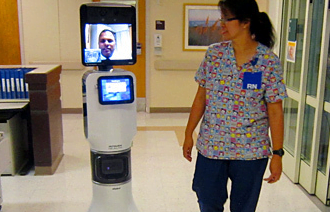![]()
The following is a guest post written by Charles Huang discussing his 3 key takeaways from attending this year’s mHealth Summit that was held in Washingon D.C. earlier this month that was recently posted on his blog:
![]()
The following is a guest post written by Charles Huang discussing his 3 key takeaways from attending this year’s mHealth Summit that was held in Washingon D.C. earlier this month that was recently posted on his blog:
At the beginning of December, the 2011 mHealth conference took place in Washington DC. For conference attendees, it was a chance to be lost amongst thousands of others in the cavernous Gaylord National Resort & Convention Center (sans WiFi or conference supplied beverages, not to mention snacks/meals) and hear about the intersection of technology, business, research and policy. For those that weren’t able to attend in person, and prefer watching versus reading – most all of the conference sessions were recorded and the videos have been graciously posted for free viewing here. There have been quite a few posts written by attendees in recent weeks, and among the good ones I’ve read, John Moore’s summary from Chilmark Research is (per the usual) pretty straight forward and spot-on.
Regardless, I promised a few folks who couldn’t make it my thoughts on the conference, the topic of “mHealth”, and broader health & technology trends in general. So here are my (overdue) main takeways and thoughts:
1) We should hope for the death of “mHealth“… and soon!
- I’m not saying this to be controversial. Smarter folks than me (including some guy named Todd Park who’s the CTO of HHS) have stated this in public. But you might wonder why this would be my first takeaway, on the heels of the largest and most well attended mHealth summit ever (~3,700 attendees), the thick 75 page program guide, and 95 presentations recorded and thought-provoking videos posted? Simply put, mHealth needs to be embedded within normal healthcare delivery. At present, it suffers from the specialization and sub-specialization endemic within the healthcare profession which results in hyperfragmentation and discrete, often uncoordinated provision of services (there are ~50 main medical specialties, with about 1/2 having ~4-6 further subspecialties). Most mHealth companies (and products and services) are tackling thin vertical healthcare opportunity slices instead of being part of an integrated, horizontal package of care and value delivery. While those who know me know that I am a fan of any type of healthcare innovation, this hyperfragmentation doesn’t really help the industry from a holistic macro perspective (i.e. tackling one or more of the big three issues: improved efficiency, improved outcomes, reduced costs). There are those who argue that integration of standalone mHealth technologies, products and services requires common standards and protocols, and that such collaboration must be fostered and facilitated by the government. While the government can certainly catalyze standardization for device-to-device communication and integration, private entities can play a role as well. The not-for-profit West Wireless Health Institute for example is working with a number of healthcare stakeholders (public and private) to develop a common infrastructure and framework along these lines, starting with their Infrastructure Independence initiative. The sooner the term “mHealth” and all its associated forms goes away and gets folded and integrated into standard healthcare delivery, the better for the healthcare industry (and economics) of our country.
2) The immediate mHealth opportunities aren’t in apps, they’re inplatform connectivity and data synthesis.

- Look, mobile apps are hot and ubiquitous, I get it. But guess what? Most consumers (beyond the Technoratti, the Quantified Self and Health 2.0 geeks) don’t care about their health enough to download health apps, less use those apps regularly (at least several times a week at the minimum, ideally daily). Health apps aren’t even in the top ten of downloaded app categories for consumers: games, weather, and social networking top the list. Health apps come in with a rank of #17 for consumers. What about providers you ask? Well, over 85% of healthcare professionals don’t use the apps they have downloaded – there is definitely app overload for providers and consumers alike. So even though there are now ~12,000 health apps in the Apple store, you’re competing with literally tens of thousands of games. And no, the solution is not “to gamify” or the “gamification” of mHealth or health apps. The immediate value opportunities are in platform connectivity and data synthesis. There are a myriad of mobile devices and sensors out on the market, consumer and provider targeted, fragmented and discrete for the most part as previously noted. Ingesting the data being collected and transmitted by these proliferating devices and simply connecting them to decision support tools, and EMRs is a huge opportunity. It might not be as sexy as a direct to consumer mobile app, but working with enterprise customers to more efficiently deliver care and improve outcomes in a timely manner solves a tremendous point of pain for providers and payors now and going forward in a world of changing risk and payment models (capitation, bundled payments, ACOs, etc). Connectivity and then data (big or not) synthesis and analytics are clear opportunities for innovation. Those that play in this space, probably aren’t accurately labeled or silo’ed as mHealth companies, but should be considered broader healthtech ones and for good reason.
3) The U.S. mHealth should learn from emerging market mHealth innovation models!

- John Moore touched on this in his mHealth Chilmark post, and I’d like to believe we share this view perhaps because of our side conversation in the hallway during the Monday session around what we thought was good so far at the mHealth summit earlier this month (and I’ve written about this before) – but we both thought that the emerging market tracks were of keen interest and value. So what’s so compelling about emerging market mHealth innovation? To me, it’s around distribution (a big N) and engagement (how often does that N use your product). An mHealth post by a well known healthcare VC stated her opinion that it was a bit weird to see MNOs like Verizon and AT&T have strong presence and presenting at mHealth. I’m scratching my head as to why this would seem odd, because it appears plainly obvious to me. MNO’s (mobile network operators) and their devices are integral parts of the lives of those who live in emerging markets. There are more cell phones than landlines in most of these areas, and therefore cell phones are used not just for communication, but for financial transactions and currency. It’s a big market as well, an estimated $200 billion market for cell phone airtime in developing countries. In short, in emerging markets most people have cell phones (the distribution N), and depend on their cell phones for daily acts of life (the engagement). Combine this with health initiatives, it’s no surprise that in emerging markets, MNOs play an integral role in mHealth because of their device distribution and daily utilization – and they achieve this often times using 1G networks and feature phones! With the ubiquity of smartphones in our LTE and 4G developed world, it makes complete sense to have MNOs play a more active role in mHealth in the US. There are now more mobile devices (~328 million) in the US and it’s territories than people (315 million) which means that many people in our country have not just 1 mobile device, but several technology enabled mobile gadgets! The MNOs are (typically) device and company agnostic: Apple or Samsung or HTC, smartphone or tablet, the MNOs simply want to push these products into consumers hands and then have consumers be dependent upon the MNOs for all the associated data consumption and service needs through these devices. In addition, beyond solving the distribution question of devices, MNOs are in a unique position to leverage clear incentives for health use/engagement (additional data service credits, additional cell phone airtime minutes, free downloads from their app stores, etc.) and can even pre-install health apps, eliminating the friction associated with app discovery and downloads. Having MNO’s play a big role going forward in mHealth and healthcare period here in the US seems pretty much like a no-brainer to me, but perhaps I’m way off the reservation on this one. WellDoc, who was at mHealth, and their MNO partnership with AT&T is a prime example of a forward thinking mHealth company working to advance diabetes care with some great results thus far. MNOs can, will, and should play an increasingly bigger and important role in mHealth in the US, not simply because of their communications infrastructure and bandwidth, but because of the prevalence of the devices they distribute which are basically human appendages at this point for most consumers, starting at earlier and earlier ages (the average age for kids who receive first cell phones is now down to less than 12 years of age). Even assuming annual cell phone service expenditures in the US has remained at 2007 levels (~$610), this implies a current US market size of $200 billion for cell phone services given ~328 million mobile devices on the market. Health/technology VCs (including the prior one mentioned previously) have commented on the lack of excitement around the projected $400M market for mhealth smartphone applications and services (and there was a VC panel at mHealth whereby panelists posited that the odds are low on whether there could be a billion dollar+ mHealth company), and this is a fair opinion if this discrete view is taken of “mHealth”. However, perhaps a better rough estimate of the future market potential might be achieved by approximating if just 1% of annual US cell phone service expenditure was dedicated to health, then this results in a $2 billion dollar annual opportunity which certainly should be a bit more appealing for startups and investors alike. The other lesson to be learned from emerging markets, I believe, is the simple distillation of healthcare problems, and the functional, utilitarian solutions that can be created to solve them without the latest technological gadgets and attempts at (shudder) “gamification”. This can be easier said than done, as Steve Jobs said, “Simple can be harder than complex”, but perhaps the technological constraints associated with emerging markets has help foster simple innovative solutions.
Those are my main (overdue) mHealth thoughts… as always, happy to chat further about any of these viewpoints and health/tech data innovation period.
About Charles Huang:
Charles is an Adviser/Mentor at Blueprint Health LLC, strategic advisor to health/technology startups, catalyst for health innovation. Charles has experience @ Spark Capital, a VC firm which focuses on the media, entertainment, and technology sectors and trying to uncover innovative opportunities in health care that overlap with Spark’s sectors and that will change and disrupt the health care industry. He is also a board observer for FitOrbit and Linkwell Health.
Please visit Charles Huang’s Blog: http://thesignaltonoise.com/
Follow Charles Huang on Twitter: @1CharlesH







